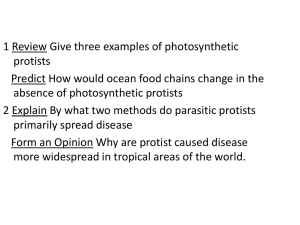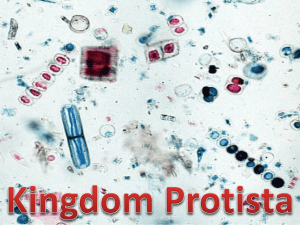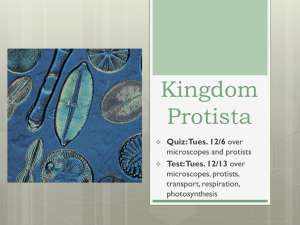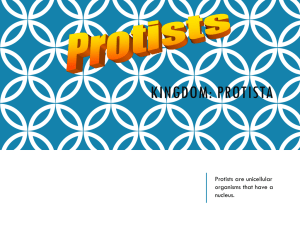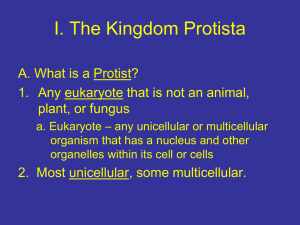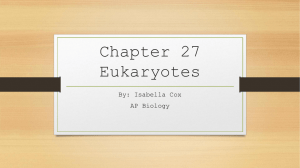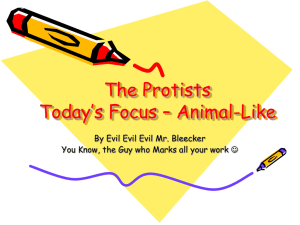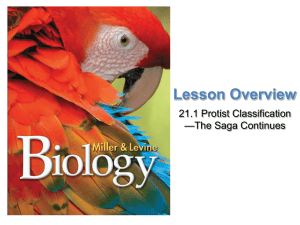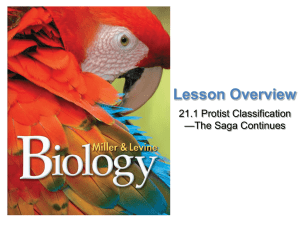PROTISTS ARE A DIVERSE GROUP OF ORGANISMS
advertisement
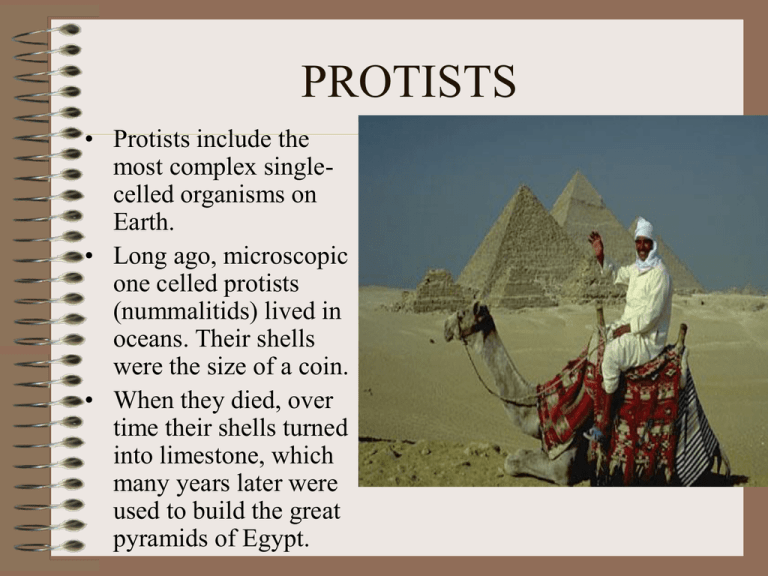
PROTISTS • Protists include the most complex singlecelled organisms on Earth. • Long ago, microscopic one celled protists (nummalitids) lived in oceans. Their shells were the size of a coin. • When they died, over time their shells turned into limestone, which many years later were used to build the great pyramids of Egypt. PROTISTS ARE A DIVERSE GROUP OF ORGANISMS • MOST PROTISTS ARE SINGLE-CELLED • PROTISTS GET THEIR ENERGY IN 3 WAYS (sunlight, eating other organisms & absorbing nutrients/materials from environment) Most Protists single-celled • Anoton van Leeuwenhoek looked at pond water (with early microscope) and saw “little animacules” or protists. • Protists = all organisms with cells having nuclei & not in animal, plant or fungi kingdom. (most single celled but some have many cells with simple structures) • Algae is protists that use sunlight as energy source (both single & multi-cellular). Seaweed (like kelp growing over 100m) and diatoms are types of algae. Slime molds are also a mulitcellular protist. Euglena = sinlge cell protist. • Protists live in any moist environment (fresh & salt water, & forest floor). • • • • Protists Get Energy In 3 Ways Capture sunlight and convert it to usable energy. Eat other organisms to obtain energy Absorb materials & nutrients form its environment. Euglena (single-celled protist) can switch modes: swim through ponds to absorb nutrients, or use sunlight to make own food PHOTOSYNTHESIS PROTIST • ALGAE: get energy from sunlight; have chlorophyll like plants to do this. Take in H2O & CO2 to make food & release O2 (photosynthesis) DIATOMS are an ex. • VOLVOX: a bunch of algae cells living together in a hollow ball as a colony (simplest type of multicellular organism) • PLANKTON: all organisms that drift in water: includes young of many animals, some adult animals & protists. If perform photosynthesis, called phytoplankton (include algae & cyanobacteria). Phytoplankton live in all oceans & PRODUCE MOST OF OYGEN ANIMALS BREATHE! EATING PROTISTS • PROTOZOA: single celled protists that eat other organisms, or decaying parts of other organisms. Paramecium swim rapidly using hairlike cilia. • Another group of protozoa use long whiplike tails called flagella. • Some others are very flexable (amoebas) and ooze along surfaces. • Many protists are parasites which cause disease like malaria. Due to protist living in mosquito that transfers to humans if bitten. It then goes through a life cycle that destroys red blood cells. DECOMPOSER PROTISTS • Protists that absorb food from their environment can be called funguslike protists. Take in materials from soil or other organisms & break down materials to get energy. Are called DECOMPOSERS. • Mold: make fuzzy like growth. Most are fungi (like bread mold) but are 3 types that are Protists: • Water Mold: funguslike protist living mostly in fresh water; form fuzzy growth on food SLIME MOLDS: live on decaying plants on forest floor. Starts out eating bacteria as single cell. Then when food is scarce, clump together as multicellular colony absorbing nutrients. Finally, form reproductive structure to release spores into the air DECOMPOSER PROTISTS CONTINUED • Plasmodial slime mold: one giant cell with many nuclei. Looks like fine net, usually found on rotting logs.

